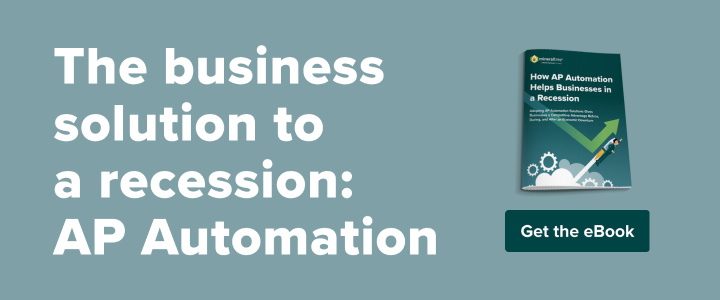From the grocery store to the gas pump, there’s no doubt about it – prices are going up. Companies are feeling the pinch as well, with 70% of companies paying more for materials in Q3 of this year, according to a survey by the National Association for Business Economics (NABE). The outlook continues to look tough as 92% of suppliers plan to increase prices during Q4, after 85% of them already raised prices in Q3.
As a result, companies are increasing pressure on AP and other back-office departments to reduce costs in order to remain competitive.
In the midst of these issues, AP departments are facing a workforce shortage and rising wages. And, if all of this isn’t challenging enough, AP departments at growing companies have to process an ever-increasing volume of invoices and payments, compelling them to find ways to do more with less.

How can your AP department rise to meet these challenges? Here are five ways you could accomplish this:
- Reduce hard costs. When you make paper check payments, you have to pay for check printing and postage, which adds up, especially if you process hundreds or thousands of checks per month. Also, keep in mind that the USPS is increasing the cost of postage, along with implementing changes that will lead to service delays, making checks more expensive and slower. You could eliminate these costs by shifting checks to digital payment methods like virtual cards and ACH.
- Save money with automation. Salaries are one of the top expenses in a company, so every manual step in the AP process not only wastes staff time, but also costs money. By automating your end-to-end AP process – as well as using a payments-as-a-service provider to offload supplier enablement, manage supplier payment details, and respond to time-consuming supplier inquiries – AP departments can save precious staff time, and potentially eliminate the need to hire more employees to keep up with an increasing volume of invoices. At the same time, staff can be more productive and gain greater job satisfaction by learning new tools and skills and by focusing on more value-added tasks.
- Leverage virtual cards for cash rebates. A growing number of companies are turning to virtual cards as a way to earn money with every supplier payment they make. Thanks to these payments, companies are achieving fast ROI – in many cases covering the cost of an AP automation platform, and in some cases, even earning profit for the company.
- Identify new global partners offering better pricing. You can diversify your supply chain by looking overseas for suppliers that offer more affordable international payment pricing. To provide a faster, more transparent FX payment experience to these international suppliers, use a payment provider with a global network of bank accounts. The provider would pay your suppliers using local banks in their countries, so payment is direct, avoiding the added cost and time delays of multiple intermediaries.
- Use analytics to get the best terms. With the help of real-time AP analytics, you can drill down into your supplier base and spend time to find opportunities to lower costs. Are you a volume buyer? Can you consolidate with one supplier to purchase in bulk? Are you able to pay early? Armed with this information, you could re-negotiate contracts to lower costs and obtain better payment terms.
BrightView Health triples invoice volume without adding AP headcount
An example of how these strategies can make a huge difference is BrightView Health, an organization focused on delivering effective addiction treatment. When the organization grew in two quick years from four treatment centers to more than 30, and from 3,000 invoices annually to more than 10,000, the AP department was under pressure to quickly scale with the rapid growth. Its solution was to transform its fully manual AP process to an automated AP solution that processes invoices in a matter of minutes, allows the company to manage the timing of payments to maximize cash flow, and includes a virtual card program that delivers cash-back rebates.
According to BrightView Health’s Controller Matt Santell, the virtual cards were a huge win because it enabled the organization to generate a new revenue stream. “It’s been great for the accounting team to show that we’re not just a cost center—now we’re able to contribute to the company’s financial success, too,” Santell said.
And thanks to these measures, the AP department was able to effectively handle all of the organizational growth without increasing its team.
Automation helps AP teams overcome worker shortages and rising inflation
There are a lot of issues that AP departments can’t control, and rising prices, worker shortages, and an ever-increasing number of invoices are just some of them. Left unchecked, these issues can take a real toll on companies and their employees. A third of companies in the NABE survey noted that increased costs are the biggest risk impacting their prospects.
Fortunately, AP departments have powerful weapons in their arsenal – AP and payment automation – that they can tap into to overcome these challenges, and at the same time, gain efficiencies, significantly reduce costs, and improve their company’s overall outlook.




